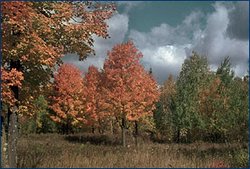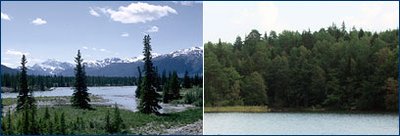Forest biome
About 420 million years ago, during the Silurian Period, ancient plants and arthropods began to occupy the land. Over the millions of years that followed, these land colonizers developed and adapted to their new habitat. The first forests were dominated by giant horsetails, club Mosses, and ferns that stood up to 40 feet tall.
 A Wisconsin forest. (Source: University of California Museum of Paleontology)
A Wisconsin forest. (Source: University of California Museum of Paleontology) Present-day forest biomes, biological communities that are dominated by trees and other woody vegetation, can be classified according to numerous characteristics, with seasonality being the most widely used. Distinct forest types also occur within each of these broad groups. Forests are important sinks of carbon dioxide and remove massive quantiles of carbon dioxide emissions from the atmosphere.
Contents
Forests Paleozoic to present
Life on Earth continued to evolve, and in the late Paleozoic, gymnosperms appeared. By the Triassic Period (245-208 mya), gymnosperms dominated the Earth's forests. In the Cretaceous Period (144-65m mya), the first flowering plants (angiosperms) appeared. They evolved together with insects, birds, and mammals and radiated rapidly, dominating the landscape by the end of the Period. The landscape changed again during the Pleistocene Ice Ages — the surface of the planet that had been dominated by tropical forests for millions of years changed, and temperate forests spread in the Northern Hemisphere.
Today, forests occupy approximately one-third of Earth's land area, account for over two-thirds of the leaf area of land plants, and contain about 70% of carbon present in living things. They have been held in reverence in folklore and worshipped in ancient religions. However, forests are becoming major casualties of civilization as human populations have increased over the past several thousand years, bringing deforestation, pollution, and industrial usage problems to this important biome.
Tropical Forest
Tropical forests are characterized by the greatest diversity (Species diversity) of species. They occur near the equator, within the area bounded by latitudes 23.5 degrees N and 23.5 degrees S. One of the major characteristics of tropical forests is their distinct seasonality: winter is absent, and only two seasons are present (rainy and dry). The length of daylight is 12 hours and varies little.
Climate
 From left: Olympic Peninsula rain forest, Washington; Patria River, Costa Rica; Ranomafana National Park, Madagascar; Hawaiian forest. (Source: University of California Museum of Paleontology)
From left: Olympic Peninsula rain forest, Washington; Patria River, Costa Rica; Ranomafana National Park, Madagascar; Hawaiian forest. (Source: University of California Museum of Paleontology) Temperature is on average 20-25° C and varies little throughout the year: the average temperatures of the three warmest and three coldest months do not differ by more than 5 degrees.
Precipitation is evenly distributed throughout the year, with annual rainfall exceeding 2000 millimeters (mm).
Soils
Soil is nutrient-poor and acidic. Decomposition is rapid and soils are subject to heavy leaching.
Canopy in tropical forests is multilayered and continuous, allowing little light penetration.
Flora and Fauna
Flora is highly diverse: one square kilometer (km) may contain as many as 100 different tree species. Trees are 25-35 meters (m) tall, with buttressed trunks and shallow roots, mostly evergreen, with large dark green leaves. Plants such as orchids, bromeliads, vines (lianas), ferns, mosses, and palms are present in tropical forests. Fauna include numerous birds, bats, small mammals, and insects.
Types of Tropical Forests
Evergreen Rainforest
Evergreen rainforests are found in tropical regions with no dry season. Lowland tropical forests are a major forest type in tropical and subtropical areas. Other types of forest may include peat swamp forests and mangrove forests.
Seasonal Rainforest
Seasonal rainforests are found in areas with short dry period in a very wet tropical region. The forest exhibits definite seasonal changes as trees undergo developmental changes simultaneously, but the general character of vegetation remains the same as in evergreen rainforests.
Semievergreen Forest
Semievergreen forests are found in areas with longer dry season. The upper tree story consists of deciduous trees, while the lower story is still evergreen.
Moist/dry Deciduous Forest (monsoon)
These forests are found in tropical regions with monsoon climates. The length of the dry season increases further as rainfall decreases. All trees are deciduous.
Environmental concerns
More than one half of tropical forests have already been destroyed, chiefly by deforestation by humans to expand agriculture and human development. Slash and burn agriculture is an ongoing activity that reduces forest area. Deforestation is a major source of carbon dioxide into the atmosphere. Furthermore, forests are a major sink for carbon dioxide to remove CO2 from the atmosphere. Wildfires should not be considered a major source of forest loss, since they represent a natural cycle that has been occurring for millennia.
Temperate Forest
Temperate forests occur in eastern North America, northeastern Asia, and western and central Europe.
Climate
 From left: Wisconsin woods; a forest along California's north coast; the forested hills of the Adirondacks, New York. (Source: University of California Museum of Paleontology)
From left: Wisconsin woods; a forest along California's north coast; the forested hills of the Adirondacks, New York. (Source: University of California Museum of Paleontology) Well-defined seasons with a distinct winter characterize this forest biome. Moderate climate and a growing season of 140-200 days during 4-6 frost-free months distinguish temperate forests.
Temperature varies from -30° C to 30° C. Precipitation (75-150 centimeters [cm]) is distributed evenly throughout the year.
Soils
Soil is fertile, enriched with decaying litter.
Flora and Fauna
Canopy is moderately dense and allows light to penetrate, resulting in well-developed and richly diversified (Species diversity) understory vegetation and stratification of animals. Flora is typically characterized by three to four tree species per square kilometer. Trees are distinguished by broad leaves that are lost annually and include such species as oak, hickory, beech, hemlock, maple, basswood, cottonwood, elm, willow, and spring-flowering herbs.
Fauna is represented by squirrels, rabbits, skunks, birds, deer, mountain lion, bobcat, timber wolf, fox, and black bear.
Types of Temperate Forests
Moist Conifer and Evergreen Broad-leaved Forest
These forests are found in temperate regions characterized by wet winters and dry summers. Rainfall is concentrated in the winter months and winters are relatively mild.
Dry Conifer Forest
Dry conifer forests dominate higher elevation zones that are characterized by low precipitation.
Mediterranean Forests
Mediterranean Forests are found in temperate regions where precipitation, less than 1000 mm per year, is concentrated in the winter.
Temperate Coniferous Forest
Temperate coniferous forests are found in regions with mild winters and high annual precipitation (greater than 2000 mm).
Temperate Broad-leaved Rainforests
Temperate broad-leaved rainforests are found in areas with mild, frost-free winters and high precipitation (more than 1500 mm) that is evenly distributed throughout the year. Only scattered remnants of original temperate forests remain.
Boreal Forest (Taiga)
Boreal forests, or taiga, represent the largest terrestrial biome. Occurring between 50 and 60 degrees north latitudes, boreal forests can be found in the broad belt of Eurasia and North America: two-thirds in Siberia with the rest in Scandinavia, Alaska, and Canada.
Climate
 From left: taiga in Jasper National Park, Alberta, Canada; forest west of Stockholm, Sweden. (Source: University of California Museum of Paleontology)
From left: taiga in Jasper National Park, Alberta, Canada; forest west of Stockholm, Sweden. (Source: University of California Museum of Paleontology) Seasons are divided into short, moist, and moderately warm summers and long, cold, and dry winters. The length of the growing season in boreal forests is 130 days. Temperatures are very low. Precipitation is primarily in the form of snow, 40-100 cm annually.
Soils
Soil is thin, nutrient-poor, and acidic.
Flora and Fauna
Canopy permits low light penetration, and as a result, understory is limited. Flora consist mostly of cold-tolerant evergreen conifers with needle-like leaves, such as pine, fir, and spruce. Fauna include woodpeckers, hawks, moose, bear, weasel, lynx, fox, wolf, deer, hares, chipmunks, shrews, and bats.
Environmental Concerns
Current extensive logging in boreal forests may soon cause their disappearance.
Wildfires
References
- Cole, Brendan (7 January 2020). "What Caused the Wildfires in Australia? Amid Worst Blazes for a Decade, 24 People are Charged with Arson ". Newsweek. Archived from the original on 14 February 2020.
In 1974, 117 million hectares of land was burnt in wildfires in central Australia.
- Kimmerer, R. W.; Lake, F. K. (2001). The Role of Indigenous Burning in Land Management. Journal of Forestry. 99(11): 36–41. doi:10.1093/jof/99.11.36. ISSN 0022-1201
- Kolden, Crystal A. (2019). "We're Not Doing Enough Prescribed Fire in the Western United States to Mitigate Wildfire Risk". Fire. 2 (2): 30. doi:10.3390/fire2020030
- Meyer, G.A.; Wells, S.G.; Jull, A.J.T. (1995). "Fire and alluvial chronology in Yellowstone National Park: Climatic and intrinsic controls on Holocene geomorphic processes". GSA Bulletin. 107 (10): 1211–1230. Bibcode:1995GSAB..107.1211M. doi:10.1130/0016-7606 107<1211:FAACIY>2.3.CO;2
- National Aeronautics and Space Administration (2017) Researchers Detect a Global Drop in Fires NASA Earth Observatory. 30 June 2017.
- Rackham, Oliver (2003). "Fire in the European Mediterranean: History". Arid Lands Newsletter. 54.
- Scott, Andrew C.; Glasspool, Ian J. (18 July 2006). "The diversification of Paleozoic fire systems and fluctuations in atmospheric oxygen concentration". Proceedings of the National Academy of Sciences. 103 (29): 10861–10865. Bibcode:2006PNAS..10310861S. doi:10.1073/pnas.0604090103. ISSN 0027-8424. PMC 1544139. PMID 16832054.
- Michael Shellenberger (2020) Apocalypse Never: Why Environmental Alarmism Hurts Us All. Harper Collins Publishers
- Stephens, Scott L.; Martin, Robert E.; Clinton, Nicholas E. (2007). "Prehistoric fire area and emissions from California's forests, woodlands, shrublands, and grasslands". Forest Ecology and Management. 251 (3): 205–216. doi:10.1016/j.foreco.2007.06.005 Forest Biome, UCMP.
- University of California Museum of Paleontology Homepage
